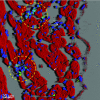Myocardial telocytes: a specific new cellular entity
- PMID: 20604817
- PMCID: PMC3823273
- DOI: 10.1111/j.1582-4934.2010.01111.x
Myocardial telocytes: a specific new cellular entity
Abstract
The existence of a new type of interstitial cells in the heart namely, interstitial Cajal-like cells (ICLC), has been described for the first time by Hinescu and Popescu in 2005. This study was then followed by an ascending trend of publications regarding the morphology, phenotype and distribution of myocardial ICLC in diverse species including human patients. Recently the new term 'telocytes' has been proposed for cells formerly known as ICLC, and the term 'telopodes' has been proposed for the prolongations of these cells. The identification of these cells is based on ultrastructural criteria. In addition, telocyters/telyopodes can be identified by several complementary approaches including methylene blue vital staining, silver impregnation and immunoreactivity against CD117/c-kit, vimentin, etc. This point of view presents critical data existing in literature, as well as own results, which unequivocally provide compelling evidence that telocytes are a new distinct cellular entity of myocardial interstitium. Several presumable functions of the myocardial telocytes are discussed: (i) intercellular signalling, (ii) cardiac repair/remodelling and (iii) stem cell nursing in cardiac renewal.
Figures






References
Publication types
MeSH terms
LinkOut - more resources
Full Text Sources

